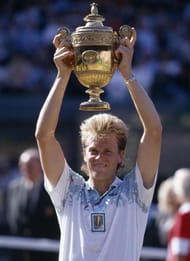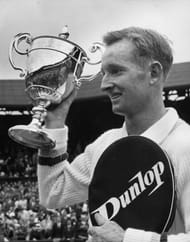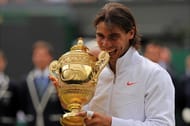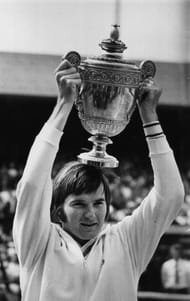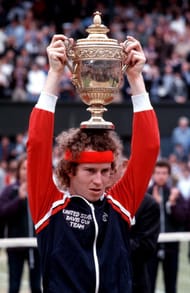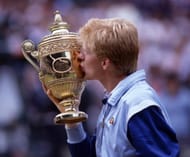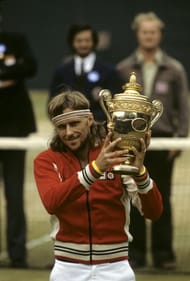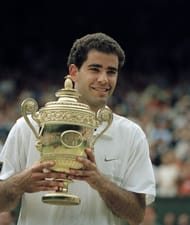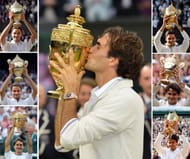NOTE: This is a list of the ten greatest men in Wimbledon history. It does not include women because the comparisons become extremely difficult. It also does not include pre-Open Era due to the lower level of competition.
Now that The Championships are behind us, we forget all the class and decorum that comes with them. We abandon the tea and the strawberries and cream, and trade them for Big Macs, Cokes and loud, raucous advertisements. It’s US Open time. But in retrospect, let us think about Wimbledon one last time before it vanishes from our short attention span. Here is a list of the ten greatest male players in Open Era Wimbledon history.
The players in this list have not simply been compiled on the basis of number of titles or finals, but the impact they have had on Wimbledon and how they have affected the course of the tournament’s history.
10. John Newcombe (2 Wins, 1 Runner-Up)
This jolly Aussie won Wimbledon twice in the Open Era and once before. Both his wins were five-setters, beating compatriot Rosewall in 1970 and American Stan Smith in 1971. Newcome also lost the 1969 final to Laver in four sets, despite having a much bigger serve and much more effective volley. Newcombe played classic 1960s tennis – serve-and-volley with a bit of groundstroke flourish. He excelled on return games and his grass court prowess was amazing.
9. Stefan Edberg (2 Wins, 1 Runner-Up)
In 1983, a young lad from Sweden accomplished something that had never been done before. He won the Boys’ Singles titles at all four Grand Slams in one year. This Swede was seen as the successor to the his magnificent countryman Borg, and he carried forward that legacy quite well.
Edberg’s fluid serve-and-volley style made him a crowd favourite everywhere he went; his loping, graceful movements and effective aggression was the precursor to Roger Federer’s style of play. Grass has always favoured the strong servers, and Edberg held true to that, winning two Wimbledon titles, beating arch-nemesis Boris Becker both times, and losing in one final, also to Becker. Edberg is considered the last Wimbledon champion to have played solely with the classical technique, and his on-court style won him two golden trophies and millions of hearts.
8. Rod Laver (2 Wins)
The grand-daddy of tennis, Rod Laver, would have definitely been higher up this list had it included pre-Open Era championships.
At the dawn of the Open Era, a thirty-year-old Laver won his third Wimbledon title and backed it up with his fourth and final title the next year on route to his historic Calendar Slam. Laver was often described as a cat on the court – his tiny, agile body retrieving effortlessly and attacking equally tirelessly.
His strong mentality and virtuoso touch won him four Wimbledon trophies, two of which were in the Open Era. Laver’s genius is still commemorated the world over, and he remains the last and only man in the Open Era to win a Calendar Slam.
7. Rafael Nadal (2 Wins, 3 Runner-Ups)
Placing Nadal above grass-courters like Edberg and Laver is sure to raise some eyebrows and spark some controversy.
However, Nadal is not your traditional Wimbledon champion. Wimbledon has always favoured the aggressive, the slick and the smooth. Nadal is the antithesis of all these traits. He can be aggressive, but chooses defence. This formula did carry him to a grand total of five Wimbledon finals, and he won two of them.
Two of these five finals can be considered among the greatest in Wimbledon history – the 2007 final, with Nadal losing in the fifth, and the 2008 epic, the greatest match ever played. Nadal’s contribution toward the change in Wimbledon has been immense. He was the first baseliner since Borg to consistently put up high results at Wimbledon, and his matches against Federer on Centre Court will go down as some of the greatest the world has seen.
6. Jimmy Connors (2 Wins, 4 Runner-Ups)
Connors is one of the grandest players in tennis history. His fighting spirit and never-say-die attitude carried him to the US Open semifinals at the age of 39.
Connors won his first Wimbledon title at the age of 22, destroying an ageing Ken Rosewall in straight sets. Connors lost to Arthur Ashe in an upset loss the following year, and went on to lose three more finals, the last one very tamely – 1-6, 1-6, 2-6. He was the first player to give Borg a run for his money at Wimbledon.
Borg had won the 1976 Championships without dropping a set. But in the 1977 final, Connors took him to a fifth and looked likely to win before Borg scrambled to a victory. Connors won his second Wimbledon title in an epic clash with countryman McEnroe, beating him in five very tight sets in the 1982 final.
5. John McEnroe (3 Wins, 2 Runner-Ups)
Nearly all of John McEnroe’s greatest moments were at Wimbledon. Although he won plentifully elsewhere, his greatest and most poignant wins, and most terrible losses as well, were all on the slick green Centre Court. McEnroe reached 5 consecutive finals between 1980 and 1984, and each and every one of them is vividly memorable.
The first was one of the greatest matches in history, with McEnroe saving seven match points to win the fourth set in the greatest tie break in history – 18-16. However, McEnroe lost the fifth set 6-8. He came back the next year for revenge and got it, defeating Borg in four sets to end Borg’s 41 match-winning streak at Wimbledon.
In 1982, McEnroe lost an epic final to his arch-rival Connors, and in 1983, he pummelled Chris Lewis 6-2, 6-2, 6-2 in a spectacular display of grass-court tennis. McEnroe won his third and final title in 1984, in the midst of one of his best seasons ever, thrashing Connors in straights. McEnroe any lower than #5? You cannot be serious.
4. Boris Becker (3 Wins, 4 Runner-Ups)
Boom Boom romped around the Wimbledon courts like no one had ever done before. He was the first person to “own Wimbledon”, as they say. He reached 6 consecutive finals between 1985 and 1991, and made his last finals appearance in 1995.
Becker burst onto the tennis world unexpectedly, defeating Kevin Curren to become the youngest Grand Slam winner in history (at the time). He backed it up by defending his title the next year, becoming the proud owner of two Wimbledon titles at 18. Becker had three classic finals with nemesis Edberg, and their battles made the late 1980s highly memorable at Wimbledon.
Becker mixed an excellent serve along with thunderous groundstrokes and a deft touch at the net. He had brilliant court sense, and knew exactly when to come in and when to hit the winner. He intimidated opponents like no one before and no one since, and walked around the locker rooms at Wimbledon as though he was their sole possessor.
Boris Becker changed Wimbledon history – he was the first man to dominate it ruthlessly, to control it with an iron fist. Borg had done that too, but this Slam really defined who Becker was. Becker was Wimbledon and Wimbledon was Becker.
3. Bjorn Borg (5 Wins, 1 Runner-Up)
Borg is tired of being relegated from the #1 spot on these lists. He held the #1 spot at the French Open, but Rafa kicked him to #2. At Wimbledon, he has been pushed down to #3. He doesn’t appreciate it. Perhaps if he hadn’t ended his career at 25, he might have been a lot higher on this list.
Borg redefined Wimbledon. Until he walked in, it was an extremely classy place where players played classical tennis and almost never ran laterally on court, only forward to the net. Borg ditched the serve-and-volley style that was rampant in those days, developed one of the first double-handed backhands, added a ton of topspin to his forehand and ran around the court like a hare, his wild locks swinging amok.
Untamed like a beast, Borg never spoke, he never twitched, he never broke concentration. He looked like an ice sculpture on court, a sublime, fast-moving one. He waged his wars from the baseline and triumphed like no one else. He still holds the highest-ever winning percentage at Wimbledon, 50 -4 (92.5%). Borg won 5 consecutive Wimbledon titles, not because of his futuristic style of play, but because of his mentality.
He won three tight five-setters, beating Connors, Tanner and then McEnroe, each time winning simply because he had ice water in his veins and refused to budge, refused to give up his trophy. He compensated for his lack of grass-court skills with the mentality of a warrior. The trophy truly was his. Bjorn Borg could have been the greatest, and maybe he is.
2. Pete Sampras (7 Wins)
The man with the plan, the power of America, Pete Sampras was the man to beat at the All England Club between 1993 and 2000. He lost just once in those 8 years, winning the golden trophy 7 out of 8 times. His huge serve and speedy running forehands were the theme of the nineties – fast-paced aggressive baselining with hints of serve-and-volley.
Sampras could play both styles effectively, and that’s what helped him win so many times at Wimbledon. Against other serve-and-volley specialists, he would push out accurate passing shots; and against weak counter-punchers, he would bombast atomic serves and slap sharp-angled volleys.
Sampras was a monster at Wimbledon, and was taken to 5 sets only once in his 7 finals. His biggest advantage was his calm head during tiebreaks – he won 6 of 9 tiebreaks in all 7 finals combined. He even bageled Ivanisevic. That was the power of Pistol Pete.
1. Roger Federer (7 Wins, 1 Runner-Up)
You knew he had to be #1. He’s Roger Federer. Nothing needs to be said about him because he is simply the greatest grass-courter in history.
Federer won 5 consecutive Wimbledon titles, and while going for his sixth, played the greatest match in all of history under fading lights, losing a match that defines this generation of tennis. Federer’s Edberg-esque style, combined with modern baseline smarts, is a perfect blend of artistry, genius, power and level-headedness. His whiplash forehand and fluid serve are the secret to his Wimbledon success, and his genius on the surface simply cannot be questioned.
Federer played three legendary finals in a row – 2007, 2008 and 2009. After losing early (for his standards) the following two years, he made a remarkable comeback to win Wimbledon for the seventh time in 2012. Federer, clad royally in his cream blazer, kissing the gold on a sunny summer afternoon is the very image of tennis of the 2000s.
Honourable mentions:
Andy Roddick (3 Runner-Ups)
At least one American had won Wimbledon in the seventies, eighties and nineties. In fact, Americans had dominated Wimbledon with Sampras, McEnroe and Connors carving their legacies at South West 19. The burden of this voluminous history was transferred to Andy Roddick’s shoulders at the turn of the millennium.
Roddick came close, but fell at the final hurdle, not once, not twice, but thrice, each time to Roger Federer. His loss in the 2009 Wimbledon finals is one of the tournament’s most famous, with Roddick being broken only once the whole match – in the very final game, serving down 14-15 in the fifth set.
Goran Ivanisevic (1 Win, 3 Runner-Ups)
The story of this giant Croat is the stuff of legend. Arguably the true ‘People’s Champion’ on Centre Court, Ivanisevic’s monstrous serve got him to three finals in the nineties. Each time, he was beaten back by an American, including two heartbreaking five-set losses. Ranked 125th, Ivanisevic won the 2001 Wimbledon as a wildcard, defeating Pat Rafter in front of a noisy Monday crowd. His story is one of Wimbledon’s greatest.
Who Are Roger Federer's Kids? Know All About Federer's Twins
